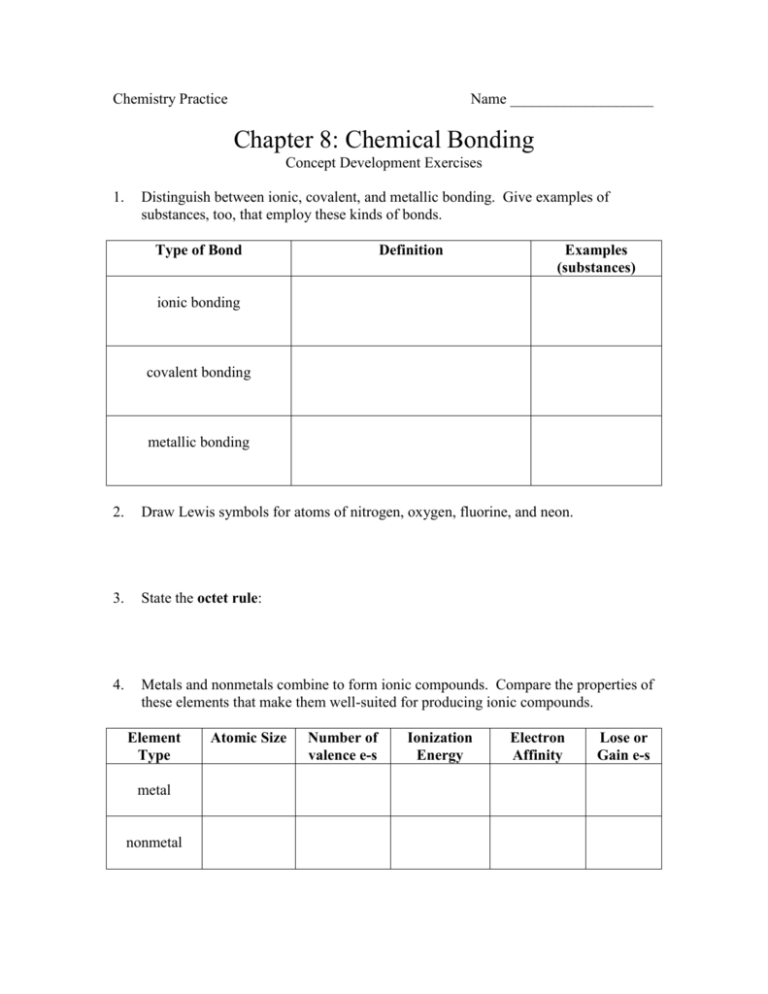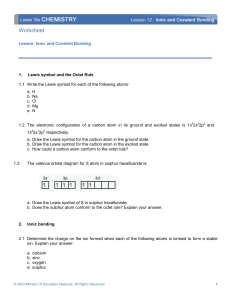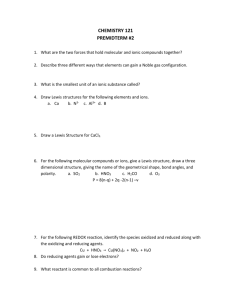5_Chap 8 Chemical Bonding CDE
advertisement

Chemistry Practice Name ___________________ Chapter 8: Chemical Bonding Concept Development Exercises 1. Distinguish between ionic, covalent, and metallic bonding. Give examples of substances, too, that employ these kinds of bonds. Type of Bond Definition Examples (substances) ionic bonding covalent bonding metallic bonding 2. Draw Lewis symbols for atoms of nitrogen, oxygen, fluorine, and neon. 3. State the octet rule: 4. Metals and nonmetals combine to form ionic compounds. Compare the properties of these elements that make them well-suited for producing ionic compounds. Element Type metal nonmetal Atomic Size Number of valence e-s Ionization Energy Electron Affinity Lose or Gain e-s 5. A. Define lattice energy: B. What factors determine the magnitude of an ionic compound’s lattice energy? C. What does the symbolism, H, mean? True or False 6. For a given arrangement of ions, the lattice energy increases as the charges on the ions increase and as their radii decrease. 7. Arrange the following compounds in order of increasing lattice energy: NaF, CsI, and CaO. 8. A. Write the electron configurations for Ca and Ca+2. B. Even though lattice energy increases with increasing ionic charge, we never find ionic compounds that contain Ca+3 ions . Explain. True or False 9. Transition-metal ions generally do not form ions that a noble gas electron configuration. 10. Specifically, from which orbitals are electrons lost when an iron atom, Fe, becomes an iron (III) ion, Fe+3? (Begin by writing their electron configurations.) 11. Write empirical formulas for compounds that contain the following ions: A. NH4+1; CO3-2 B. Sr+2; Cl-1 C. Al+3; SO4-2 D. Fe+2; PO4-3 12. The reaction between sodium metal and chlorine gas is exothermic (H = -411 kJ). Follow the Born-Haber cycle for NaCl below (and p. 308, text) and verify the enthalpy change for the reaction: Na(s) + ½ Cl2 (g) NaCl(s) 1. vaporization of Na(s) to Na(g): 2. atomization of Cl2 (g) to Cl(g): 3. ionization of Na(g) to Na+1(g): 4. ionization of Cl(g) to Cl-1(g): 5. Na+1(g) and Cl-1(g) to NaCl(s) lattice: 13. Identify several properties of ionic substances: True or False 14. The vast majority of chemical substances do not have the characteristics of ionic substances. 15. Specifically, what holds the hydrogen atoms together in an H2 molecule? 16. Draw Lewis models for the following covalent compounds: HF, H2O, NH3, and CH4. 17. Draw Lewis models for CO2 and N2. True or False 18. As a general rule, the distance between bonded atoms decreases as the number of shared electrons increases. 19. Distinguish between a polar covalent bond and a nonpolar covalent bond. 20. Define electronegativity: 21. Identify the electronegativity trends in the periodic table (from left to right along a period and downward in a group). True or False 22. The greater the difference in electronegativity between two bonded atoms, the more polar their bond. 23. Define dipole: 24. If two equal and opposite charges, Q+ and Q- are separated by a distance r, the magnitude of the dipole moment is the product of Q and r: = Qr. Dipole moments are measured in debyes (D), a unit that equals 3.34 x 10-30 C-m. Work through Sample Exercise 8.5 on pp. 315-316 in the text. Drawing Lewis Structures Lewis structures can help us understand the bonding in many compounds and are frequently used when discussing the properties of molecules. Drawing Lewis structures is an important skill that you should practice. 25. Draw Lewis structures for the following: A. PCl3 B. HCN C. NO+1 26. Draw Lewis structures for the following: A. BrO3-1 B. ClO2-1 C. PO4-3 27. A. Define formal charge: B. How do we calculate formal charge? 28. Determine the formal charges associated with each atom associated with the Lewis structures from questions 26 and 27 above. PCl3 HCN NO+1 BrO3-1 ClO2-1 PO4-3 True or False 29. The sum of the formal charges will always equal the overall charge on an ion. 30. The concept of formal charge can help us choose between alternative Lewis structures. For example, carbon dioxide could feature two double bonds in the molecule or a single and a triple covalent bond between the carbon atom and the oxygen atoms (see p. 320, bottom). A. What guidelines do we follow to choose the most correct Lewis structure? B. The cyanate ion, NCO-1, has three possible Lewis structures. Draw these three Lewis structures and assign formal charges to the atoms in each structure. C. Which of the three structures is preferred? Explain. 31. A. What are resonance structures? B. The O-O bonds in ozone, O3, are often described as “one-and-a-half” bonds. Is this description consistent with the idea of resonance? C. Draw resonance structures for benzene, C6H6. Exceptions to the Octet Rule The octet rule fails in many situations involving covalent bonding, and are of three main types: 1. Molecules and polyatomic ions containing an odd number of electrons; 2. Molecules and polyatomic ions in which an atom has fewer than an octet of valence electrons; 3. Molecules and polyatomic ions in which an atom has more than an octet of valence electrons. 32. Draw Lewis structures for nitric oxide, NO, boron trifluoride, BF3, phosphorus pentachloride, PCl5, and the tetrachloroiodide ion, ICl4-1. Bond Enthalpies 33. Calculate the enthalpy change for the following gas-phase reaction: CH4 (g) + Cl2 (g) CHCl3 (g) + HCl (g) 34. Nitroglycerin, C3H5N3O9 (l), is an explosive compound that decomposes into nitrogen, carbon dioxide, water, and oxygen gases. Why is this reaction so energetic? This project is funded by a grant awarded under the President’s Community Based Job Training Grant as implemented by the U.S. Department of Labor’s Employment and Training Administration (CB-15-162-06-60). NCC is an equal opportunity employer and does not discriminate on the following basis: against any individual in the United States, on the basis of race, color, religion, sex, national origin, age disability, political affiliation or belief; and against any beneficiary of programs financially assisted under Title I of the Workforce Investment Act of 1998 (WIA), on the basis of the beneficiary’s citizenship/status as a lawfully admitted immigrant authorized to work in the United States, or his or her participation in any WIA Title I-financially assisted program or activity. This product was funded by a grant awarded under the President’s High Growth Job Training Initiative, as implemented by the U.S. Department of Labor’s Employment & Training Administration. The information contained in this product was created by a grantee organization and does not necessarily reflect the official position of the U.S. Department of Labor. All references to non-governmental companies or organizations, their services, products, or resources are offered for informational purposes and should not be construed as an endorsement by the Department of Labor. This product is copyrighted by the institution that created it and is intended for individual organizational, non-commercial use only.





